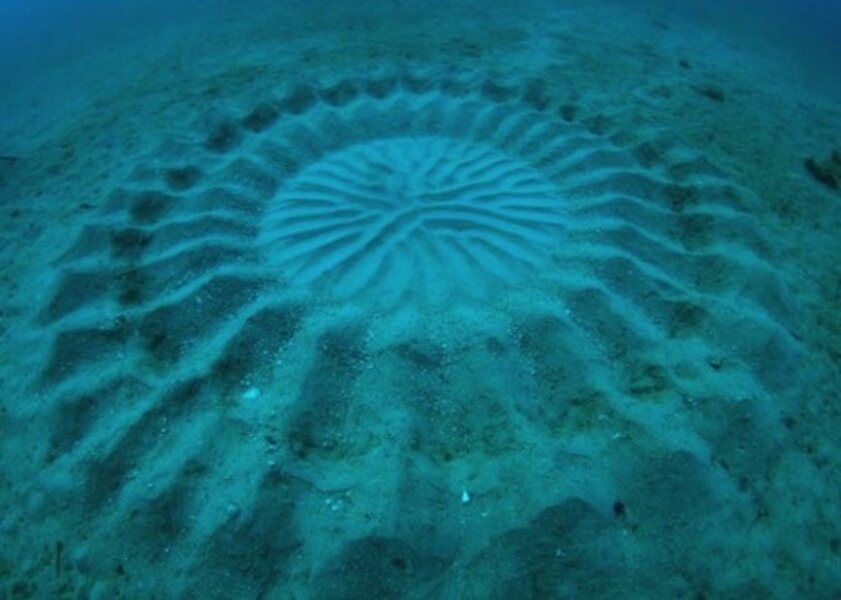Lovestruck pufferfish responsible for strange sea floor crop circles
Loading...
In 1995, divers noticed a beautiful, strange circular pattern on the seafloor off Japan, and soon after, more circles were discovered nearby. Some likened these formations to "underwater crop circles." The geometric formations mysteriously came and went, and for more than a decade, nobody knew what made them.
Finally, the creator of these remarkable formations was found: a newly discovered species of pufferfish. Further study showed these small pufferfish make the ornate circles to attract mates. Males laboriously flap their fins as they swim along the seafloor, resulting in disrupted sediment and amazing circular patterns. Although the fish are only about 12 centimeters (5 inches) long, the formations they make measure about 2 meters (7 feet) in diameter.
When the circles are finished, females come to inspect them. If they like what they see, they reproduce with the males, said Hiroshi Kawase, the curator of the Coastal Branch of Natural History Museum and Institute in Chiba, Japan. But nobody knows exactly what the females are looking for in these circles or what traits they find desirable, Kawase told LiveScience. [See Video of Pufferfish Making Seafloor Circles]
Unique circles
Pufferfish mating involves females laying eggs in the fine sediments in the center of the circles, and then the males fertilizing them externally. Then, the females vanish, and the males stay for another six days, perhaps to guard the eggs, the study noted.
Males of some species of cichlids (a type of fish) are known to construct crater-shaped mounds that females visit to have their eggs fertilized, Kawase said. For example, male featherfin cichlids in Africa's Lake Tanganyika build small bowls out of the sand, and display them to females before mating there, said Alex Jordan, a researcher at the University of Texas at Austin who wasn't involved in this study.
But this new pufferfish's geometric patterns have three features never seen before. First, they involve radially aligned ridges and valleys outside the nest site. Second, the male decorates these ridges with fragments of shells. Third, the male gathers fine sediments to give the resulting formation a distinctive look and coloring, Kawase said. [Photos: Pufferfish Make Seafloor Circles to Mate]
Strangely enough, the male "gathers" the fine sediments using the circular pattern itself, Kawase said. A fluid dynamics test using a half-size model of one of these circles found that the upstream portion of the circle funnels water and fine sediments toward the center. Then, the downstream peaks and valleys funnel the water outward. The speed of water was slowed by nearly 25 percent in the center, where the eggs are laid, the study noted.
Bowerbirds of the sea?
It takes about seven to nine days for the pufferfish to construct the circles. The male pufferfish don't maintain these formations, and underwater currents wash them away relatively quickly. Kawase said they likely give up their old formations because the circles exhaust the fine sediment in the area, and thus must be built anew in areas with fresh sediment.
When Jordan first heard about the circles, he guessed a much bigger fish would have made them. The fact that such a small animal makes such a large formation is "pretty cool, and suggests some underlying biological reason for the size, like poor visibility at depth, or distance between individuals that means males have to make large nests to be found by females," he told LiveScience.
Research describing the pufferfish formations was published in July in the journal Scientific Reports. "It's a nice clean study because it provides a definite answer to the question — something that is very rare in biology," Jordan said.
The formations are very similar to so-called "bowers" — display sites built by various animals like bowerbirds in which to strut their stuff before mating. In this case, the formations may serve solely to gather fine sediments, which females could use to choose their mate, Jordan said.
But until this idea is tested, nobody will know. "The one caveat I have is that there is no evidence that females care about anything more than the fine sand, and even that's a stretch," Jordan said. "The beautiful lines and structure could serve only to channel those particles to the center, and have no aesthetic purpose."
Although Jordan said he doesn't think that's the case, the idea that the fine sediments are important to females would be "biologically interesting, because it would suggest that function is more important than appearance," he said.
Email Douglas Main or follow him on Twitter or Google+. Follow us @livescience, Facebookor Google+. Article originally on LiveScience.
- Photos: The Freakiest-Looking Fish
- 12 Strangest Sights on Google Earth
- Mysterious Stone Structure Discovered Beneath Sea of Galilee
Copyright 2013 LiveScience, a TechMediaNetwork company. All rights reserved. This material may not be published, broadcast, rewritten or redistributed.







